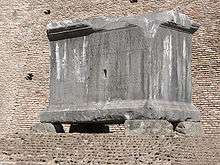Neratius Cerealis
Neratius or Naeratius Cerealis (floruit 328–358) was a Roman senator and politician, Praefectus urbi and Consul.

Biography
He was the brother of Galla, wife of Julius Constantius, and half-brother of Vulcacius Rufinus, and probably had a son named Neratius Scopius. He owned some balnea on the Esquiline Hill in Rome, the balnea Neratii Cerealis, located between the church built by Pope Liberius (the modern Basilica di Santa Maria Maggiore) and the Basilica of Junius Bassus; maybe it was the domus Neratiorum, owned by an aristocratic family of the 2nd century, to which he added the balnea around 360.
In 328 he was praefectus annonae of Rome.[1]
In late summer 351 he was in Sirmium, member of the tribunal processing Photinus; the city was under control of Emperor Constantius II, while Rome was occupied by the usurper Magnentius. It is probable that Neratius remained with Constantius until he was appointed Praefectus urbi of Rome, on September 26, 352, a little time after the usurper had left the city. As Praefectus he asked that to divert the grain for Capua, Puteoli, and other cities of Campania to Rome. His office ended on December 8, 353.
On the right of the Arch of Septimius Severus in the Roman Forum, between the arch and the Curia, it is still extant the basis of a statue erected by Neratius in honour of Constantius II; the Emperor is celebrated in the epigraph (CIL VI, 1158) as restitutor urbis et orbis, extinctor pestiferae tyrannidis, a reference to his victory over Magnentius.
Neratius was consul in 358.
Jerome records the answer that a young widow, Marcella, gave to Neratius when he proposed to marry her, late in his life: she said that if she wanted to marry again, she would choose a husband, not an inheritance.[2]
Notes
- Codex Theodosianus xiv.24.1, issued on March 1, 328.
- Jerome, Letters, 127.2.
Bibliography
- Martindale, John Robert, Arnold Hugh Martin Jones, John Morris, "Cerealis 2", The Prosopography of the Later Roman Empire, Cambridge University Press, 1971, ISBN 0-521-07233-6, p. 197-199.
| Political offices | ||
|---|---|---|
| Preceded by Flavius Iulius Constantius Augustus IX, Flavius Claudius Julianus Caesar II |
Consul of the Roman Empire 358 with Censorius Datianus |
Succeeded by Flavius Eusebius, Flavius Hypatius |
| Preceded by Septimius Mnasea |
Praefectus urbi of Rome September 352 – December 353 |
Succeeded by Memmius Vitrasius Orfitus (I) |